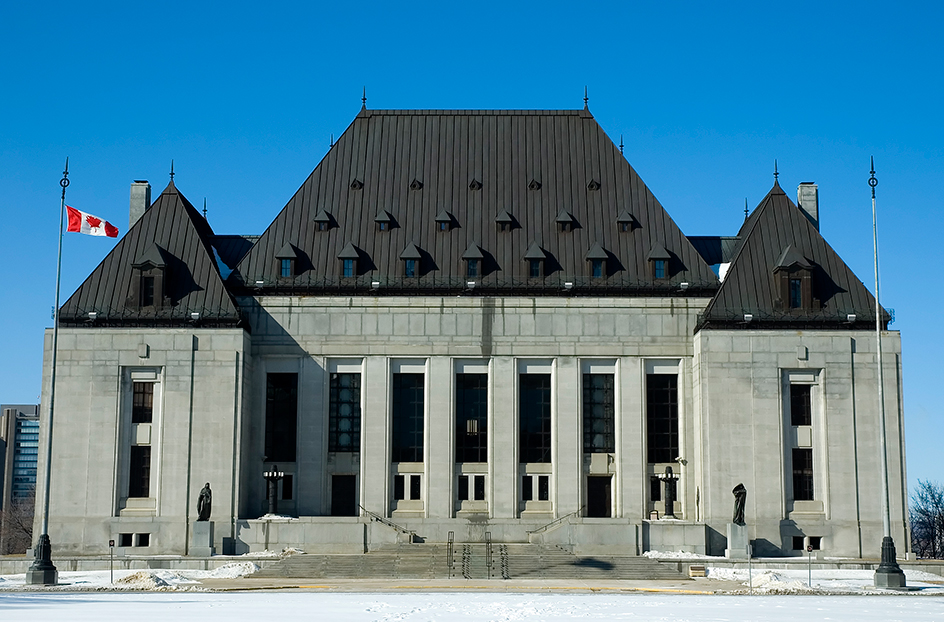Supreme Court of Canada is Canada’s highest court. It is the final court of appeal in all areas of Canadian law. The court hears cases involving provincial or federal laws or Canada’s constitution. The Supreme Court also advises the federal government on constitutional questions. The court meets in Ottawa.
Organization.
The Supreme Court has nine members—a chief justice and eight associate judges called puisne << PYOO nee >> judges. The term puisne means junior, or associate. Traditionally, three of the nine judges have come from Ontario, two from the Prairie Provinces and British Columbia, and one from the Atlantic Provinces. In addition, by law, at least three of the judges must come from Quebec. This rule ensures that at least three members of the court have a background in Quebec’s distinctive civil law system. All the other provinces have common law systems. In civil law systems, judges base their decisions on written codes. In common law systems, judges base their rulings on previous court decisions in similar cases.

The prime minister of Canada chooses the Supreme Court judges. The judges are then appointed by the governor general in council. The governor general in council is the governor general of Canada acting with the advice and consent of the Cabinet. By law, those eligible to serve on the Supreme Court include current and former judges of provincial superior courts. Current and former barristers and advocates who have belonged to a provincial bar (body of lawyers) for at least 10 years also are eligible. Barristers and advocates are lawyers who go to court. Judges of the Supreme Court must retire at the age of 75.
Authority.
The Supreme Court deals primarily with cases of broad public significance. Most cases brought before the court involve Canada’s Criminal Code, other federal or provincial laws, or administrative acts of the federal government. But the court also decides constitutional cases. Most of the constitutional cases deal with the Canadian bill of rights, called the Charter of Rights and Freedoms, or with the division of powers between the federal and provincial governments.
Lawsuits involving private law can be appealed to the Supreme Court only if the court grants a person or group leave (permission) to make the appeal. Private law deals with the rights and obligations people have in their relations with each other, see Law (Branches of law) . The court grants leave to appeal if a panel of three of its judges decides the case is of sufficient public importance. The Supreme Court also must decide whether to grant leave in most cases involving criminal, administrative, or constitutional law. In most cases, no reasons are given for the decision to grant or refuse leave to appeal. Certain criminal cases may be brought before the court without leave. For example, any conviction of first-degree murder carries with it an automatic right of appeal to the Supreme Court.
Before it can hear any case, the court must form a quorum. A quorum consists of five judges. All nine judges usually do not participate in a single case, though the full court assembles for important constitutional cases. Most Supreme Court cases are heard by a panel of seven judges or by the full court. In most of its cases, the court explains the reasoning on which its decision is based.
History.
Canada’s Parliament created the Supreme Court in 1875 as a general court of appeal. At that time, the court had six judges. A seventh judge was added in 1927, and the court was expanded to nine members in 1949.
From 1875 to 1949, the Supreme Court was supreme in name only. In reality, it was merely an intermediate appellate court. Its legal decisions could be appealed to the Judicial Committee of the Privy Council in London, England. Canadians could even choose to bypass the Supreme Court by appealing their case directly to the Judicial Committee from the highest court of appeal in their province. The committee, which consisted chiefly of judges from Britain’s highest courts, served as Canada’s highest court of appeal. Distinguished members of the Supreme Court of Canada occasionally served on the committee.
In 1933, all appeals of Canadian criminal cases to the Judicial Committee were abolished. In 1949, all other Canadian appeals to the committee were eliminated, and the Supreme Court became Canada’s highest court of appeal in all areas of law.
Until 1975, parties to any private lawsuit that involved $10,000 or more were granted an automatic right of appeal to the Supreme Court from the federal court of appeal or from any of the provincial courts of appeal. As a result, many of the cases heard by the Supreme Court involved no significant issue of public law. In 1975, the court was granted the authority to decide which cases involving private lawsuits were important enough for it to hear. Afterward, the court significantly reduced the number of private lawsuits it handled annually.
The Supreme Court gained a more prominent role in Canadian life after the government adopted the Charter of Rights and Freedoms in 1982. Since then, in cases involving the charter, the court has declared a number of federal and provincial laws unconstitutional. In 1988, for example, the court overturned a federal law that made abortions illegal unless they were authorized by special hospital committees.
In 2013, Prime Minister Stephen Harper chose Marc Nadon of the Federal Court of Appeal to replace retiring Supreme Court Justice Morris Fish. Fish had been appointed from the Quebec Court of Appeal in 2003. In 2014, the Supreme Court rejected Nadon’s appointment, because he had not served on a Quebec court recently. By law, three justices must come from Quebec.
See also Dickson, Brian ; Lamer, Antonio ; McLachlin, Beverley Marian .
